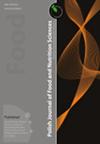Abeliophyllum distichum Nakai提取物浸种提高大豆芽产量和营养价值
IF 2.3
4区 农林科学
Q3 FOOD SCIENCE & TECHNOLOGY
引用次数: 0
摘要
白叶参(abelophyllum distichum Nakai)是一种观赏植物,含有多种具有药用特性的植物化学物质。使用不同的植物提取物来提高豆芽的产量和/或质量是很常见的,豆芽是最便宜但营养丰富的食品之一。本研究的目的是研究双芒花提取物(ADE)对豆芽产量和营养价值的影响。大豆种子分别用浓度为0.5% (ADE-0.5)、1% (ADE-1)、3% (ADE-3)、5% (ADE-5)的ADE溶液浸泡。ADE浓度对产量和不同营养成分的影响存在差异。以ADE-3处理的豆芽产量和维生素C含量最高。其中必需氨基酸含量最高的是ADE-1,而总异黄酮含量最高的是ADE-5,矿物质含量最高的是ADE-5。产量、颜色、维生素C、氨基酸和异黄酮含量的综合结果表明,1%或3%的双苦参提取物可以提高大豆种子的发芽率和营养成分含量。本文章由计算机程序翻译,如有差异,请以英文原文为准。
Soaking Soybean Seeds with Abeliophyllum distichum Nakai Extract Increased the Yield and Nutritional Value of Soybean Sprouts
Abeliophyllum distichum Nakai, an ornamental plant, contains a wide range of phytochemicals having pharmaceutical properties. The use of dif - ferent plant-based extracts for the enhancement of yield and/or quality of soybean sprouts, one of the most inexpensive but nutritious food products, is common. The objective of this study was to examine the effect of A. distichum flower extract (ADE) on the yield and nutritional value of soybean sprouts. Soybean seeds were soaked in ADE solutions with concentrations ( w/v ) of 0.5% (ADE-0.5), 1% (ADE-1), 3% (ADE-3), and 5% (ADE-5). The effect of ADE concentration on the yield and different nutrient components varied. The highest soybean sprout yield and vitamin C content were found with ADE-3. The most abundant essential amino acid content was detected in ADE-1, whereas the greatest amounts of total isoflavones and to tal minerals were determined in ADE-5 and the ADE-untreated control, respectively. Overall results of yield, color, and contents of vitamin C, amino acids, and isoflavones suggest that 1% or 3% of A. distichum extract could be an optimum concentration to soak the soybean seeds for higher sprout yield and nutrient content.
求助全文
通过发布文献求助,成功后即可免费获取论文全文。
去求助
来源期刊

Polish Journal of Food and Nutrition Sciences
FOOD SCIENCE & TECHNOLOGY-
CiteScore
4.30
自引率
12.50%
发文量
25
审稿时长
20 weeks
期刊介绍:
The Polish Journal of Food and Nutrition Sciences publishes original, basic and applied papers, reviews and short communications on fundamental and applied food research in the following Sections:
-Food Technology:
Innovative technology of food development including biotechnological and microbiological aspects
Effects of processing on food composition and nutritional value
-Food Chemistry:
Bioactive constituents of foods
Chemistry relating to major and minor components of food
Analytical methods
-Food Quality and Functionality:
Sensory methodologies
Functional properties of food
Food physics
Quality, storage and safety of food
-Nutritional Research Section:
Nutritional studies relating to major and minor components of food (excluding works related to questionnaire
surveys)
-“News” section:
Announcements of congresses
Miscellanea
 求助内容:
求助内容: 应助结果提醒方式:
应助结果提醒方式:


